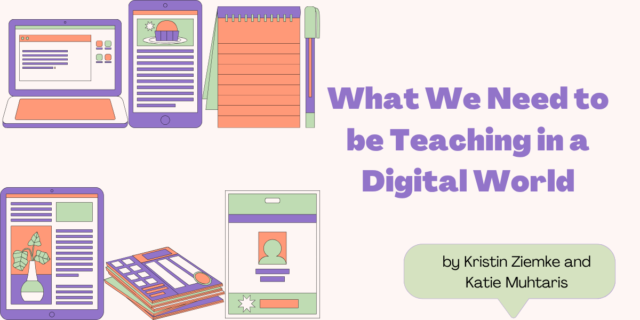
Fellow Educators,
This year will be unprecedented, even for those of us who have had years and years of experience welcoming students back to school. We’ll need to rely on all that we know about teaching while, at the same time, being ready to learn and adjust moment-by-moment to an ever-changing learning environment. Whether you are teaching students in a virtual setting, hybrid, or in-person we know it will not be a year like any other we’ve had before.
For many years now, the two of us have been working to unite strong, kid-centered pedagogy with the best that technology has to offer in the classroom. Now, as so many teachers find themselves relying on technology more than ever before, we’ve organized the lessons and teaching moves that we know we’ll be relying on the most in the upcoming school year so that you can find them easily and use them in your planning. The crosswalk document that follows shows you where to find help in our books (Amplify: Digital Teaching and Learning in the K-6 Classroom and Read the World: Rethinking Literacy for Empathy and Action in a Digital Age) as well as guidance for adjusting these lessons to distance learning. (If you don’t have a copy of either of these books, we’ve included a few sample PDFs to give you an idea of what’s in them.) The lessons and teaching suggestions on the crosswalk address setting your students up for success, teaching literacy, using technology to communicate productively, and engaging students with inquiry—even from a distance.
We often talk about how there are so many lessons and strategies that we never knew we needed to teach kids. Some examples are how to clean a device, how to write a blog comment, and how to record a video blog that doesn’t look like The Blair Witch Project. Now, we find ourselves needing to teach lessons that we could never have imagined we would have to teach—lessons about how to build classroom communities online without having the opportunity to build that community in person first, for example. The linked document holds a little of both.
We hope that these resources, as well as those we’ve compiled on our Read The World Distance Learning Website will be of use to you. This school year will be a challenge the likes of which we have not seen in our lifetimes. We’re honored to be going into it side by side.
Kristin & Katie
Fellow Educators,
This year will be unprecedented, even for those of us who have had years and years of experience welcoming students back to school. We’ll need to rely on all that we know about teaching while, at the same time, being ready to learn and adjust moment-by-moment to an ever-changing learning environment. Whether you are teaching students in a virtual setting, hybrid, or in-person we know it will not be a year like any other we’ve had before.
For many years now, the two of us have been working to unite strong, kid-centered pedagogy with the best that technology has to offer in the classroom. Now, as so many teachers find themselves relying on technology more than ever before, we’ve organized the lessons and teaching moves that we know we’ll be relying on the most in the upcoming school year so that you can find them easily and use them in your planning. The crosswalk document that follows shows you where to find help in our books (Amplify: Digital Teaching and Learning in the K-6 Classroom and Read the World: Rethinking Literacy for Empathy and Action in a Digital Age) as well as guidance for adjusting these lessons to distance learning. (If you don’t have a copy of either of these books, we’ve included a few sample PDFs to give you an idea of what’s in them.) The lessons and teaching suggestions on the crosswalk address setting your students up for success, teaching literacy, using technology to communicate productively, and engaging students with inquiry—even from a distance.
We often talk about how there are so many lessons and strategies that we never knew we needed to teach kids. Some examples are how to clean a device, how to write a blog comment, and how to record a video blog that doesn’t look like The Blair Witch Project. Now, we find ourselves needing to teach lessons that we could never have imagined we would have to teach—lessons about how to build classroom communities online without having the opportunity to build that community in person first, for example. The linked document holds a little of both.
We hope that these resources, as well as those we’ve compiled on our Read The World Distance Learning Website will be of use to you. This school year will be a challenge the likes of which we have not seen in our lifetimes. We’re honored to be going into it side by side.
Kristin & Katie
NO TIME TO READ? WATCH SOME VIDEOS!
For more distance teaching support, click over to our blog post containing all three Facebook LIVE video recordings with Kristen Ziemke and Katie Muhtaris.
 Kristin Ziemke is a teacher, staff developer, and the co-author of Read the World: Rethinking Literacy for Empathy and Action in a Digital Age, Amplify: Digital Teaching and Learning in the K-6 Classroom, and Connecting Comprehension and Technology. Recognized as an international expert in literacy, inquiry, and technology, Kristin collaborates with organizations around the world to develop learning experiences that redefine school. Currently serving as a resident teacher and learning innovation specialist for the Big Shoulders Fund, Kristin has been recognized as an Apple Distinguished Educator, Chicago Public Schools Tech Innovator of the Year, National Board Certified Teacher, and Emerging Leader by the Chicago Council on Global Affairs. Her work has been featured by Apple, EdWeek, Mindshift, and Scholastic. Find Kristen on Twitter @KristinZiemke.
Kristin Ziemke is a teacher, staff developer, and the co-author of Read the World: Rethinking Literacy for Empathy and Action in a Digital Age, Amplify: Digital Teaching and Learning in the K-6 Classroom, and Connecting Comprehension and Technology. Recognized as an international expert in literacy, inquiry, and technology, Kristin collaborates with organizations around the world to develop learning experiences that redefine school. Currently serving as a resident teacher and learning innovation specialist for the Big Shoulders Fund, Kristin has been recognized as an Apple Distinguished Educator, Chicago Public Schools Tech Innovator of the Year, National Board Certified Teacher, and Emerging Leader by the Chicago Council on Global Affairs. Her work has been featured by Apple, EdWeek, Mindshift, and Scholastic. Find Kristen on Twitter @KristinZiemke.
 Katie Muhtaris is a co-author of Read the World Now: Rethinking Literacy for Empathy and Action in a Digital Age, Amplify: Digital Teaching and Learning in the K-6 Classroom, and Connecting Comprehension and Technology. She currently works with kindergarten through fifth grade as an Instructional Digital Age Learning Coach, supporting teachers and students in the areas of literacy, humanities, and technology. As an experienced educator in both urban and suburban settings, Katie consults with districts to implement innovative instructional practices with a close eye on student impact. Katie is an internationally recognized expert in technology and workshop model integration. Katie works with districts to develop innovative learning experiences for teachers and students that merge the best of print and digital resources and tools. Her other areas of interest include inquiry based instructional models, integrated social emotional practices, and building cultures of support and risk taking among teachers. Find Katie on Twitter @KatieMuhtaris.
Katie Muhtaris is a co-author of Read the World Now: Rethinking Literacy for Empathy and Action in a Digital Age, Amplify: Digital Teaching and Learning in the K-6 Classroom, and Connecting Comprehension and Technology. She currently works with kindergarten through fifth grade as an Instructional Digital Age Learning Coach, supporting teachers and students in the areas of literacy, humanities, and technology. As an experienced educator in both urban and suburban settings, Katie consults with districts to implement innovative instructional practices with a close eye on student impact. Katie is an internationally recognized expert in technology and workshop model integration. Katie works with districts to develop innovative learning experiences for teachers and students that merge the best of print and digital resources and tools. Her other areas of interest include inquiry based instructional models, integrated social emotional practices, and building cultures of support and risk taking among teachers. Find Katie on Twitter @KatieMuhtaris.



